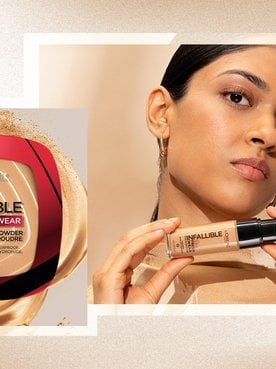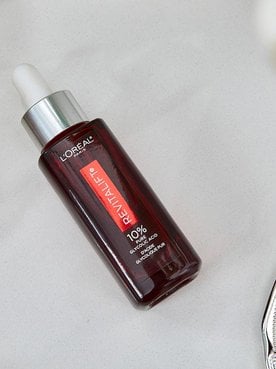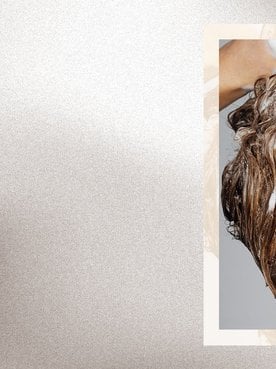Having smooth, radiant skin is a beauty goal that many of us share—and achieving it is often as simple as learning how to exfoliate your skin properly. If exfoliation isn’t already a part of your routine, it’s a great time to start. This one step offers countless benefits to the overall look and feel of your skin. However, it’s important to learn the best way to exfoliate your face and body before diving in. An aggressive approach can lead to redness, dryness, and irritation, especially if you have sensitive skin.
To make sure you’re exfoliating the right way, read on. This guide will teach you everything you need to know about how to exfoliate from head to toe for smooth, luminous-looking skin.
What Is Exfoliation?
Exfoliation is the process of removing dead skin cells from the surface of your skin. There are two kinds of exfoliation: physical and chemical. Physical exfoliation (also known as mechanical exfoliation) involves scrubbing the skin’s surface with a scrub, dry brush, or other exfoliating skin tool. Chemical exfoliation involves resurfacing skincare ingredients such as salicylic acid, alpha-hydroxy acids (like glycolic acid, lactic acid, and mandelic acid), retinol, poly-hydroxy acids, or enzymes to break down surface buildup. Typically, these types of skin exfoliation formulas are liquid exfoliators, but the active ingredients can also be found in face creams, cleansers, or serums.

How Often Should You Exfoliate?
Everyone’s skin reacts differently to exfoliating. For the most part, the best way to exfoliate your body is to do so a few times a week. Determining when and how to exfoliate your face, however, is trickier, with your skin type playing a large role. People with sensitive skin can typically handle exfoliating once a week, while others may be able to exfoliate a few times per week. Overall, less is more—otherwise, you risk over-exfoliating your skin, which can cause discomfort or contribute to concerns like dryness and redness.
What Are the Benefits of Exfoliating?
Whether you choose physical or chemical exfoliation, exfoliating can remove the buildup of dead skin cells from your skin’s surface. This one small action provides invaluable benefits to your skin. Regular (and gentle) exfoliation can help:
- Improve the look of fine lines and wrinkles
- Reduce the appearance of discoloration, like sun spots
- Minimize the appearance of enlarged pores
- Revitalize dull-looking skin
- Smooth rough, uneven texture
- Promote clearer-looking skin
- Reduce breakouts
- Improve the skin’s absorption of serums and moisturizers
- Prepare skin for a smoother, closer shave

How to Exfoliate Your Face
Exfoliating for your skin type is the best way to optimize your skincare routine. If you have an oily, acne-prone, mature, or normal skin type, you’ll likely be able to tolerate either physical or chemical exfoliation, especially with higher concentrations of active ingredients. However, those who have sensitive skin should look for a gentler way to exfoliate. Chemical exfoliants or coarse physical scrubs may be too harsh on your delicate complexion. Instead, consider a mild exfoliating serum or exfoliating cleanser with active ingredients at low concentrations—this way, you’ll get the benefits of exfoliating with a minimized risk of irritation.
When you find the right balance, you’ll see that regular exfoliation can lead to smoother makeup application and a radiant glow, regardless of your skin type. When in doubt, consult a dermatologist who can give you personalized recommendations for the type of exfoliation that will be best for you.
Use a physical exfoliant
When determining how to exfoliate skin using a physical exfoliant, consider your skin type and the ingredients in your chosen formula. The more sensitive your skin is, the gentler you’ll want to be. Scrubs with small granules that dissolve quickly, like sugar or jojoba beads, won’t be as harsh as a product that uses ingredients like sand or crushed seeds.
Generally, the best way to exfoliate your face with a scrub is to start with freshly cleansed skin. Your skin should be wet when exfoliating with a physical exfoliant—this will prevent the formula from being too abrasive. Gently massage the scrub onto your face using circular motions, avoiding the eye area. Be sure not to press too hard—while a more intense scrub-down might feel more productive, it could also damage your skin and lead to issues down the line. Once you’ve finished exfoliating, rinse your face thoroughly and apply a hydrating serum and moisturizer to help replenish your skin (don’t forget SPF for daytime).
Try a chemical exfoliant
Chemical exfoliants come in many forms, so deciding how to use an exfoliator properly can be a challenge—it can vary depending on your skin type and the strength of the formula you choose. Regardless of which kind you pick, your face should be dry when using a chemical exfoliant, and you should follow the packaging's usage guidelines.
Paying attention to the instructions is crucial to successful skin exfoliation when using a chemical exfoliant. Some chemical exfoliants have to be rinsed off, while others are left on; they’re all effective, but you won’t get the results you’re looking for if you don’t follow the instructions!
One of the most well-known and best ways to exfoliate your face is via a chemical peel. Many of these formulas are very potent, with high concentrations of active ingredients to deliver noticeable results. They’re typically done by a trained professional and rinsed off after a few minutes.
If you want to get similar results at home, we suggest adding L’Oréal Paris Bright Reveal Dark Spot Exfoliating Peel to your routine. The potent formula contains a blend of multi-sized acids and helps improve the appearance of dark spots, renew skin texture, and soften the skin. Apply it to freshly cleansed skin and leave it on for about 15 minutes before rinsing your face thoroughly. From there, you can apply hydrating toners, serums, and moisturizers as usual.
Formulas like toners or serums, meanwhile, tend to be gentler and don’t need to be rinsed off. L’Oréal Paris RevitaLift Derm Intensives 10% Pure Glycolic Acid Serum is applied to clean, dry skin before hydrating serums and moisturizers to help improve skin tone and texture. This skin exfoliation formula is designed to be gentle enough for daily use. If you’re looking for something especially powerful to address fine lines and wrinkles, consider a retinol serum like L’Oréal Paris RevitaLift Night Serum, 0.3% Pure Retinol. Start by applying it at night twice a week and work your way up as your skin tolerates it.
After skin exfoliation, make sure you moisturize, which will help prevent dryness or irritation—and enhance your new glow. Sunscreen is also key, as some chemical exfoliants can leave your skin more sensitive to UV damage.

Exfoliate your lips
If you have dry lips, exfoliating your lips can help remove dead skin and reveal a smoother texture. Typically, you’ll want to use manual exfoliation on your lips. Use a dedicated lip scrub or lightly rub your lips with a damp washcloth to help lift away dead, flaky skin. After exfoliating, follow up with hydrating lip balm to lock in moisture.
Shop the Products
How To Exfoliate Your Body
The best way to exfoliate your body is to do so on clean skin before shaving. As you do when exfoliating your face, you’ll want to select a skin exfoliator for your body carefully to ensure it’s right for your skin type. There are plenty of options here, so don’t be afraid to experiment. And, of course, don’t forget to moisturize afterward. Using a body lotion after exfoliating your body is key for smooth, radiant skin.
Try skin exfoliation via dry brushing
To remove dead skin cells as well as increase blood flow throughout your body, experiment with dry brushing, a technique that is used by individuals around the world to achieve smoother, more even-looking skin.
The best way to exfoliate the body with a dry brush is to do so with a dry tool on clean, dry skin before showering. Brush the bristles against your skin in an upward motion, moving the tool toward your heart as you work. (For example, if you’re dry brushing your legs, you’d start at the ankle and finish near your bikini line.) Go over each area a few times to make sure you’re effectively removing dead skin cells. After you’re done dry brushing, rinse off in the shower, then apply body lotion to nourish your freshly exfoliated skin.
Use a body scrub
Using a body scrub in the shower is a great way to tackle rough skin in areas like the feet, elbows, or legs. It’s also an ideal way to prepare for shaving, as removing dead skin cells will allow for a smoother shave. Like physical exfoliants for the face, there are a wide range of body scrubs and ingredients to choose from, including formulas made with coffee grounds, sugar, and salt.
No matter which you choose, the technique for exfoliating with a body scrub is the same as it is with a face scrub: Be sure your skin is damp (but not soaking wet) before applying the body scrub. If your skin is too wet, the scrub won’t be able to adhere to your skin. Apply a generous amount of the scrub to your body, then massage it into your skin using circular motions. Don’t use too much pressure, especially if you’re using a formula with exfoliating granules that won’t melt, lest you risk irritating your skin. Once you’re done, rinse off the scrub, then complete the rest of your shower routine.
Cleanse with an exfoliating body wash
Using an exfoliating body wash or shower gel tends to be a great option for all skin types. Because exfoliating body washes are quickly rinsed off, they’re usually suitable for sensitive skin and are unlikely to cause irritation when used properly. Look out for one with alpha-hydroxy acids like glycolic or lactic acids if you want smoother, brighter skin, or salicylic acid if you’re looking to help stave off blemishes. As for the method, it’s more or less the same as with your standard, non-exfoliating body wash. However, be sure to read the instructions on your chosen product to ensure you’re using it as directed.
Moisturize with an exfoliating body lotion
When you use an exfoliator in a nourishing format like body oil or body lotion, you get the best of both worlds—resurfaced skin that’s hydrated for an extra smooth and luminous look. However, be sure not to apply one of these formulas to freshly shaven skin, as the active ingredients could cause irritation. Choose a formula that aligns with your needs, and apply a thin, even layer to damp skin after showering.
What Should You Do After Exfoliating?
Now that you’ve learned how to exfoliate your skin, you need to know one of the most important factors in maintaining its healthy appearance—aftercare. Remember that when you’re exfoliating, you’re removing the dead layer of skin on the surface to reveal the fresh, new skin underneath. That new skin is especially sensitive to sun damage, and applying sunscreen after can help protect it from UV rays.
Look for a broad-spectrum formula with an SPF of at least 15, such as L’Oréal Paris Bright Reveal Broad Spectrum SPF 50 Daily UV Lotion. The non-comedogenic formula helps protect against UVA and UVB rays and blends seamlessly into all skin tones without leaving behind a white cast. Don’t forget to take other sun protection measures—like wearing protective clothing and avoiding direct sunlight at midday—to help keep your newly exfoliated skin safe from the sun’s rays.
Shop the Product
Next Up: 8 Skincare and Makeup Tips To Transform Your Skin Into a Dewy Dream
Photo Courtesy of L'Oréal Paris







